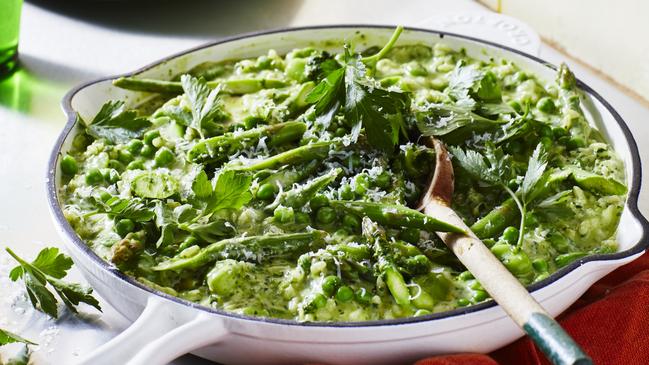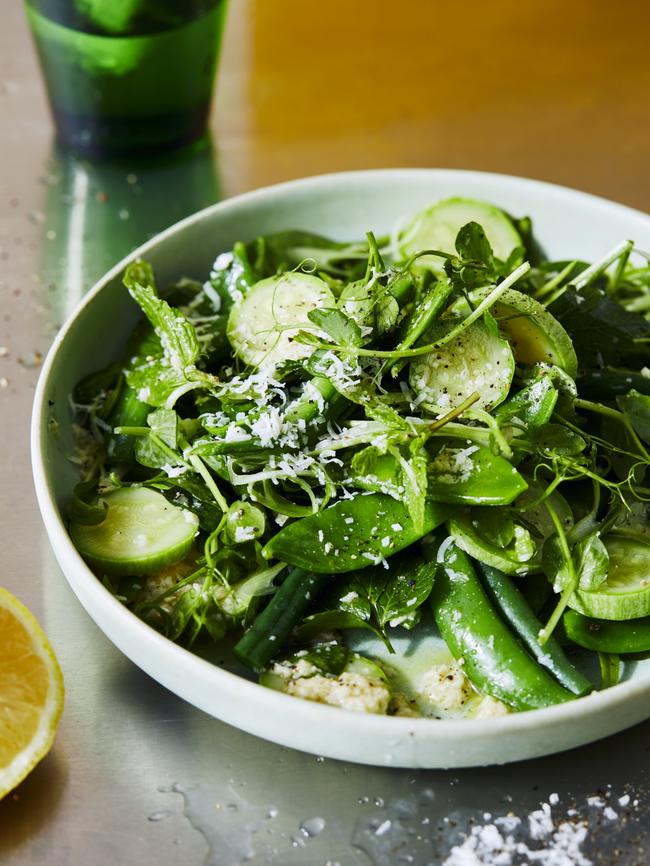Risotto verde
The verde paste stirred through this risotto elevates it to operatic levels. Serve with a spring salad made with peas and parmesan.

Few composers have quite the sense of occasion as Giuseppe Verdi, whose operas are known for their memorable moments (the kind that get turned into pasta sauce ads). And so, though the green paste stirred through this risotto is named “verde” for the colour, I’m tempted to call it a “Verdi paste” for the way it elevates this dish to operatic levels. Serve the risotto with a simple spring salad made with peas and Parmesan.
Risotto verde
1.5 litres good quality chicken or vegetable stock
¼ cup extra-virgin olive oil
1 large onion, finely diced
2 cups (400g) arborio rice
½ cup white wine
100g butter
100g parmesan (plus the rind if you have it)
Verde paste
4 garlic cloves
1 bunch parsley, washed
100g baby spinach, washed
½ lemon, zest and juice
½ cup extra-virgin olive oil
Garnish (see tips)
1 bunch asparagus, roughly chopped
2 cups baby peas
1 cup broad beans, blanched and double podded
Gently heat stock and keep at a simmer on low heat (not boiling). If you have any parmesan rinds, add them to the stock pot too. In a heavy-based pan, heat the olive oil gently. Pop in the finely diced onion, wait for a sizzle and then close the lid for 10 minutes, stirring occasionally until the onion is transparent but not brown. Add the arborio rice and cook for 2 minutes until the rice is glossy, stirring the whole time to ensure every granule is coated with oil. Keep the pan on medium heat. Splash in the wine and deglaze the pan, stirring all the time. Once the alcohol has stopped stinging your eyes, start to add the stock, one ladleful at a time, occasionally agitating the pan and stirring with a wooden spoon to keep the rice from sticking to the bottom.
To make the verde paste, blitz together garlic, spinach, parsley (leaving some leaves for garnish), lemon zest and juice and oil.
When each ladleful of stock has been absorbed into the risotto and you start seeing the base of the pan, add more stock, repeating the process for 20-25 minutes. Once there is only about a cup of stock left, taste to see if the rice is cooked (the middle shouldn’t taste or feel chalky). Keep going if you need more, adding extra boiled water from the kettle if needed. Risotto should still be al dente (with a bit of chew), the sauce silky, loose and creamy, rather than stiff and gluey.
Once done, stir through the asparagus, peas and podded broad beans (if using) and bring back to a gentle simmer. Take off heat, stir in butter, parmesan and verde paste, put a lid on and leave for 5 minutes to rest. Taste and correct for seasoning. Serve in flat bowls, give it a bit of a shake to settle it, drizzle over an extra glug of olive oil, grate over extra parmesan and add a final crack of pepper and some reserved parsley leaves. Serves 6

Pea & parmesan salad
100g snow peas
100g sugar snap peas
1 punnet snow pea tendrils
1-2 zucchini, sliced into rounds
4 spring onions, chopped
¼ cup mint leaves
¼ cup parsley leaves
Parmesan vinaigrette
2 tablespoons white wine vinegar
1-2 garlic cloves, minced
1 teaspoon Dijon mustard
¼ cup olive oil
50g parmesan, finely grated
Salt flakes and freshly ground black pepper
Fork together vinaigrette ingredients until combined. Season to taste. Toss greens through vinaigrette just before serving.
Top tips
If using a commercial stock, add some water to dilute it – it’s much easier to add seasoning, it’s far harder to take it back
This one’s all about the colour and the parmesan. If you’d prefer to keep the green stuff simple, a cup of frozen peas will do.
The butter is optional – though more butter is always better, as far as I’m concerned
alice@aliceinframes.com



To join the conversation, please log in. Don't have an account? Register
Join the conversation, you are commenting as Logout